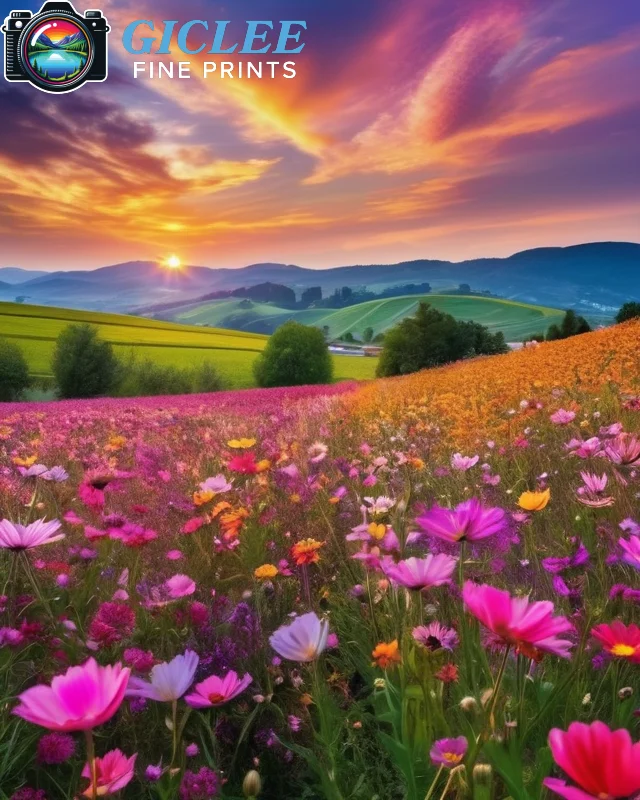
Art reproduction is a powerful way for artists to share their work with a wider audience, enabling them to create multiple copies of original pieces. Whether you’re a fine artist looking to offer reproductions or a collector interested in high-quality prints, understanding the various art reproduction methods is essential for achieving the best results. At Giclee Fine Prints, we specialize in a range of reproduction techniques, ensuring that your art is represented with precision and beauty.
Giclee Printing: The Gold Standard for Art Reproduction
Giclee printing is widely regarded as the gold standard for art reproduction due to its exceptional quality and color accuracy. Using high-resolution inkjet printers and archival inks, giclee prints offer rich, vibrant colors and fine details, closely matching the original artwork.
Key Features:
- High Resolution: Giclee prints are created with inkjet printers that can produce images at resolutions up to 1200 DPI, ensuring sharpness and clarity even for large-scale prints.
- Archival-Quality Inks: The inks used in giclee printing are pigment-based and designed to be long-lasting. They are fade-resistant and can last for decades without deteriorating, making giclee prints ideal for collectors and galleries.
- Variety of Paper Options: Giclee printing can be done on a wide range of papers, including fine art paper, canvas, and even metal prints. This flexibility allows artists to choose the medium that best suits their work.
Best For:
- Fine art reproductions of original paintings, drawings, and mixed media pieces where color accuracy and detail are essential.
- Photographers seeking to create high-quality, archival prints of their images.
Offset Lithography: Traditional Reproduction for Large Editions
Offset lithography is a traditional printing method used to reproduce art in large quantities. It involves transferring ink from a printing plate to a rubber blanket, which then applies the ink to the paper. This method is often used for posters, books, and prints that require high-volume production.
Key Features:
- Cost-Effective for Large Runs: Offset lithography is ideal for creating large editions of prints at a lower cost per unit. While the setup cost for the printing plates is higher, it becomes more economical as the print quantity increases.
- High-Quality Reproductions: Offset lithography can produce sharp, high-quality images, although it may not match the color depth and resolution of giclee prints.
- Best for Commercial Prints: This method is commonly used for creating posters, books, and commercial art prints, where large quantities are needed.
Best For:
- Artists or publishers producing high-volume editions of prints for retail or mass distribution.
- Posters and prints where large quantities and lower production costs are the priority.
Screen Printing: Ideal for Graphic and Poster Art
Screen printing, also known as silkscreen printing, is a method that involves pressing ink through a stencil on a mesh screen to create an image. Each color in the artwork is applied with a separate screen, making it a labor-intensive but versatile process that produces bold, vibrant colors.
Key Features:
- Bold, Vibrant Colors: Screen printing is known for its ability to create vibrant, opaque colors, making it ideal for graphic art, posters, and pop art.
- Textural Quality: Screen printing produces a slightly raised texture, giving the print a tactile quality that adds depth and dimension.
- Best for Limited Colors: Since each color requires a separate screen, screen printing is best for designs with limited color palettes, such as posters or graphic art.
Best For:
- Graphic designers and illustrators creating posters, T-shirts, or other merchandise with bold, eye-catching designs.
- Limited-edition prints where the textural quality of screen printing enhances the artwork.

Digital Printing: Fast and Versatile for Short Runs
Digital printing is a modern reproduction method that uses digital files to print directly onto a wide range of materials, including paper, canvas, and metal. While it shares some similarities with giclee printing, it is generally more affordable and better suited for short print runs.
Key Features:
- Fast and Affordable: Digital printing allows for quick production and is ideal for short-run prints or one-off pieces. It’s a cost-effective option for artists who want to test the market with smaller editions.
- Versatile: Digital printing can be done on various surfaces, from photo paper to metal prints and canvas. This makes it a flexible option for artists with diverse printing needs.
- Lower Resolution than Giclee: While digital printing offers good quality, it may not reach the same level of color accuracy or detail as giclee prints.
Best For:
- Artists who need short-run editions or prints on demand without high setup costs.
- Photographers and illustrators looking for fast, high-quality prints for portfolios, exhibitions, or commercial use.
Intaglio Printing: A Fine Art Method with Rich Textures
Intaglio printing is one of the oldest methods of art reproduction and involves engraving or etching an image onto a metal plate. The plate is inked, and the ink is pressed into the paper under high pressure, resulting in prints with deep, rich textures. Common intaglio techniques include etching, engraving, and mezzotint.
Key Features:
- Rich Texture and Detail: Intaglio prints have a distinct tactile quality, with deep textures and fine lines that give the artwork a handcrafted feel.
- Labor-Intensive: This method is labor-intensive, as each print requires individual inking and pressing. It’s typically used for limited-edition prints due to the time and effort involved.
- Highly Collectible: Intaglio prints are often considered fine art in their own right, making them highly collectible among art enthusiasts.
Best For:
- Fine artists who want to create handmade, limited-edition prints with a tactile, artisanal quality.
- Collectors seeking high-end, traditional art prints with a unique, handcrafted appeal.
Relief Printing: Block Printing for Bold, Graphic Designs
Relief printing, including woodcut, linocut, and block printing, involves carving an image into a material such as wood or linoleum. Ink is applied to the raised surface, and the image is pressed onto paper. This technique is known for its bold, graphic lines and is commonly used in traditional printmaking.
Key Features:
- Bold and Expressive: Relief printing creates prints with strong lines and high contrast, making it perfect for graphic designs, typography, and illustrative work.
- Handmade Quality: Each print has a handmade, tactile feel that enhances the overall aesthetic of the piece.
- Best for Simplicity: Since relief printing works best with bold lines and simple shapes, it’s ideal for prints with a limited color palette or minimalist designs.
Best For:
- Artists and printmakers creating limited-edition prints with a graphic, handmade quality.
- Illustrators who want to explore traditional printmaking techniques for their work.

Lithography: Fine Art Printing for Detailed Reproductions
Lithography is a method of art reproduction that involves drawing an image on a stone or metal plate with a greasy substance, which repels water but holds ink. The inked image is then transferred to paper, producing highly detailed prints. Lithography is often used for fine art reproduction, including original lithographs created by the artist.
Key Features:
- Detailed and Delicate: Lithography allows for fine details and delicate shading, making it ideal for reproducing drawings, illustrations, and paintings.
- Hand-Printed Process: Like intaglio printing, lithography is a labor-intensive process, with each print requiring careful inking and pressing.
- Limited Editions: Lithographs are often produced in limited editions, adding to their value as collectible art prints.
Best For:
- Fine artists and illustrators seeking high-quality reproductions of original works with delicate lines and shading.
- Collectors looking for limited-edition prints that reflect the craftsmanship of traditional printmaking.
Monoprints and Monotypes: One-of-a-Kind Art Reproductions
Monoprints and monotypes are unique printmaking methods that result in one-of-a-kind prints. A monoprint is created by altering an existing printing plate for each print, while a monotype is made by painting or drawing directly on a smooth surface and transferring the image to paper.
Key Features:
- One-of-a-Kind Prints: Both monoprints and monotypes produce unique, unrepeatable prints, making each piece a one-of-a-kind work of art.
- Spontaneity and Creativity: These methods allow for spontaneous, creative expression, as each print can be altered or adjusted during the process.
- Best for Experimental Art: Monoprints and monotypes are ideal for artists who enjoy experimentation and creating truly original works.
Best For:
- Artists looking to produce one-of-a-kind prints with a sense of spontaneity and creativity.
- Collectors seeking unique, original pieces that stand apart from traditional editions.
Contact Us
Our address is: 3816 Pioneer Trail Ste #3, South Lake Tahoe, CA 96150
Email: Info@gicleefineprints.com
FAQs
Giclee printing is widely regarded as the best method for fine art prints due to its color accuracy, detail, and longevity.
Giclee printing uses archival-quality inks and higher resolutions than standard digital printing, making it ideal for fine art reproductions. Digital printing is more affordable and better suited for short runs or commercial prints.
Yes, screen printing is often used for fine art prints, especially for graphic art and pop art, where bold, vibrant colors are key.


